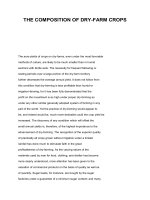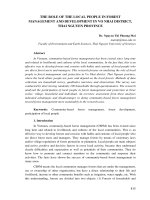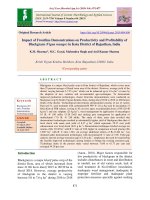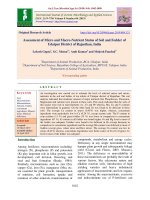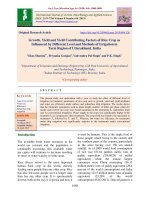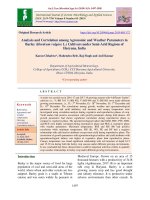Composition of sewage and non-sewage water of different district of Haryana, India
Bạn đang xem bản rút gọn của tài liệu. Xem và tải ngay bản đầy đủ của tài liệu tại đây (437.93 KB, 12 trang )
Int.J.Curr.Microbiol.App.Sci (2019) 8(9): 2771-2782
International Journal of Current Microbiology and Applied Sciences
ISSN: 2319-7706 Volume 8 Number 09 (2019)
Journal homepage:
Original Research Article
/>
Composition of Sewage and Non-Sewage Water of
Different District of Haryana, India
Sushil*, R. S. Garhwal and Dinesh
Department of Soil Science, CCS Haryana Agricultural University Hisar-125004, India
*Corresponding author
ABSTRACT
Keywords
Chemical oxygen
demand, Biological
oxygen demand, sewer
water, cadmium,
cobalt, lead
Article Info
Accepted:
24 August 2019
Available Online:
10 September 2019
Raw sewer and tube well water samples were collected from various sewer disposal sites and nearby
fields in Kurukshetra, Kaithal, Narwana, Jind and Charkhi Dadri (Haryana) where these waters are
directly used for irrigating the crops. The mean values of pH (8.49), electrical conductivity (1.91
dSm-1), chemical oxygen demand (762.0 mg L-1) and biological oxygen demand (227.5 mg L-1) were
highest in sewage water of Kaithal. The highest mean value of Ca2+ (4.84 mgL-1) was observed in the
sewage water of Charkhi Dadri while Mg2+ (7.41 mg L-1) and Na+ (10.50 mg L-1) were recorded
highest in the sewage water of Narwana. The mean value of K+ content was highest (2.07 mg L-1) in
the sewage water of Jind district. The mean values of anions like carbonates (CO32- 0.90 mg L-1) and
bicarbonates (HCO3- 4.52 mg L-1) were highest in district Jind, sulphate (SO42-0.74 mg L-1) in district
Kaithal and Cl- (12.06 mg L-1) in the sewage water of Narwana. Highest mean value of zinc (0.19 mg
L-1) content was observed in the sewage water of Kaithal. The highest mean value of copper (0.20
mg L-1) was observed in sewage water of Kurukshetra and Kaithal district. The highest mean value
of Fe (6.45 mg L-1) was observed in the sewage water of Kurukshetra district. The highest mean
value of Mn (0.48 mg L-1) was observed in the sewage water of Kaithal district. The mean value of
cadmium (Cd) was highest in the sewage water of Jind (0.31 mg L-1). Chromium (Cr) content was
absent in the sewage and non-sewage water collected from all the sites in Haryana. The mean value
of lead (Pb) (0.13 mg L-1) was highest in the sewage water of Kaithal. The mean value of cobalt (Co)
(0.06 mg L-1) was highest in the sewage water of Kurukshetra district.
Introduction
Population growth, especially in the
developing countries, has increased the
demand for a huge quantity of water for
domestic, municipal, and industrial sectors.
With the increasing scarcity of fresh water
resources that are available to agriculture, the
use of urban waste water for irrigation is
increasing. The growth of towns, cities, and
development of industries by 19th century
leads to problem of disposal of sewage, which
encouraged the use of sewage wastewater in
irrigation. Waste water is composed of 99.9
per cent water and 0.1 per cent of other
materials (suspended colloidal and dissolved
solids). The practice of use of domestic
sewage in farming is becoming prevalent as
the demand of water is increasing. Due to fast
industrial development and the growth of
population, the availability of water decreases
day-to- day. This increase in the population
has led to increased demand of water and the
increased generation of waste water. The high
quality water is preserved and the lower
quality is used for agricultural purposes.
2771
Int.J.Curr.Microbiol.App.Sci (2019) 8(9): 2771-2782
Irrigation with sewage became a prevalent
practice in arid and semiarid regions, where it
was readily available and economic to
freshwater. The final aim of sewage
management is the protection of the
environment which the ultimate goal of
wastewater management in a manner
corresponding with public health and socioeconomic concerns. The increase in world
population has not only put pressure on
limited water resources but also increased the
volume of waste generation (Darvishi et al.,
2010). The growing competition for scarce
water resources, coupled with law of limiting
ground water pumping, has led to utilization
of low quality water in irrigated agriculture.
An estimated 38,354 million litres per day of
sewage water is generated in major cities of
India. The sewage water is a potential water
resource with stability of water quantity and
reliable supply. Nutrients and water being the
most critical inputs in agriculture, harvesting
the nutrients and irrigation potential of sewage
water are of prime importance for maximizing
the food, fodder and fuel production. Sewage
water is a rich source of both beneficial and
harmful elements. Many small to medium
scale industries operating in peri-urban
residential areas of cities dispose their
contaminated effluents directly in sewage
system.
The composition of sewer waters is dependent
on the composition and quantity of the
industrial effluents discharged into the sewer
systems (Kirkham, 1974; Larsen et al., 1975;
Arora et al., 1985) thus, the resultant sewer
water contains variable amounts of plant
nutrients, toxic metals, oils, grease, fat and
soluble salts. The raw sewer water gets entry
into the agricultural fields and may affect the
soil, plants, human and animal health,
depending upon its composition (Anderson
and Nilsson, ‘1973; Gupta et al., 1986, 1994;
Narwal et al., 1990).
Opportunities exist as sewage effluents from
municipal origin are rich in organic matter and
also contain appreciable amounts of major and
micronutrients (Feign et al., 1991; Pescod,
1992; Gupta et al., 1998; Brar et al., 2000).
Accordingly nutrient levels of soils are
expected to improve considerably with
continuous irrigation with sewage (Baddesha
et al., 1986; Narwal et al., 1993; Brar et al.,
2000). The increased competition for
freshwater among urban and semi-urban
centres, industries and agriculture, particularly
irrigated agriculture under severe pressure as
irrigation has been the largest user of water
(Van der Hoek et al., 2002). Therefore, the use
of treated, partially-treated or untreated
wastewater has received more attention (Yao
et al., 2013). Bouwer (1994) stressed about the
need of water management on local, regional,
national and international level. Keeping the
above facts in view, the study was undertaken
to evaluate the chemical composition of
sewage and non-sewage water of peri-urban
area of Haryana state so as to use this water
for agricultural purposes.
Materials and Methods
Study area
The present study has been conducted in
Haryana state which is one the northern state
of India. The geographical location of the state
is between 27°39' to 30°35' N latitude and
74°28' and 77°36' E longitude. In present
study, five districts were selected for the
present study namely (i) Kurukshetra, (ii)
Kaithal, (iii) Narwana, (iv) Jind and (v)
Charkhi Dadri. In each district, four sites were
selected for the sampling of sewage and nonsewage sources of water. From each site two
sample of sewage and two sample of nonsewage water were collected from discharge
out-lets. The sewage water sample were
collected in duplicate, i.e. one already treated
with a mixture of 1:1 HNO3 and distilled
2772
Int.J.Curr.Microbiol.App.Sci (2019) 8(9): 2771-2782
water to avoid adsorption of heavy metals on
the walls of bottle and in another un-acidified
bottle rinsed with only distilled water. Unacidified sewage water samples were used for
the determination of pH, EC, COD, BOD,
soluble cations and anions, micro-nutrients
and heavy metals.
described by (Chesnin and Yien, 1951). Total
Zn, Cu, Mn, Fe, Cd, Pb, Co, and Cr were
estimated in acidified digested samples using
atomic absorption spectrophotometer (AAS).
The statistical analysis was accomplished by
Statistical Software Package for Agricultural
Research Workers (Sheoran et al., 1998).
Sample analysis
Results and Discussion
The pH was determined by systronic digital
pH meter (Jackson, 1973). Electrical
conductivity was estimated in the filtered
sample with the help of Elico conductivity
meter bridge (Jackson, 1973). Biological
oxygen demand was calculated by multiplying
organic matter content of sewage water by
0.711 (Schulz, 1938). The chemical oxygen
demand (COD) of sewage water was
determined by open reflux method (Tandon,
1998). Ca2+ was estimated by compleximeteric
titration with standard 0.01 N EDTA and pH12 obtained with the help of NaOH by using
ammonium purpurate as indicator, when pink
colour of the solution changed to purple
(Jackson, 1973). Mg2+ was estimated by
titrating with 0.01N EDTA by buffering the
solution to pH 10 with NH4Cl-NH4OH buffer
by using Erichrome black T indicator
(Jackson, 1973). Na+ was determined by flame
photometer with the help of a standard curve
outlined by (Jackson, 1973). K+ was
determined by flame photometer with the help
of a standard curve outlined by (Jackson,
1967). CO32- and HCO32-was estimated by
titrating a known volume of the sewage water
with standard H2SO4 first in the presence of
phenolphthalein and then with methyl red
indicator (Richards, 1954). Cl- was determined
by titrating with standard (0.02 N) AgNO3
solution using potassium chromate as
indicator. The end point was obtained when
white precipitate of AgCl change to brick red
colour suggesting complete precipitation of
chloride with Ag (Richards, 1954). SO42- was
determined by EDTA-titration method as
Chemical and biological composition of
sewage and non-sewage water in some cities
of Haryana is presented in table 1. The pH
value of sewage water was found higher (8.49
to 8.58) in the sewage water of Kaithal
followed by Kurukshetra (8.31 to 8.36),
Narwana (8.10 to 8.40), Jind (8.00 to 8.42)
and Charkhi Dadri (8.00 to 8.12). The mean
pH value of the sewage water collected from
all the sites was higher (8.54) as compared to
the pH of non-sewage water (8.22). The pH of
sewage water ranged from 8.00 to 8.58
whereas it was ranged from 7.80-8.28 in nonsewage water. The EC value of sewage water
was found higher (1.63 to 2.18 dSm-1) in the
sewage water of Kaithal followed by
Kurukshetra (1.51 to 1.27 dSm-1), Narwana
(1.08 to 1.57 dSm-1), Jind (1.05 to 1.63 dSm-1)
and Charkhi Dadri (1.04 to 1.13 dSm-1). The
mean EC value of the sewage water collected
from all the sites was higher (1.91 dSm-1) as
compared to the EC of non-sewage water
(0.34 dSm-1). Electrical conductivity of
sewage water ranged from 1.04 to 2.18 dSm-1
where as it was ranged from 0.19 to 0.35 dSm1
in non-sewage water. Similar results were
reported by Singh et al., (2017) during their
survey of five sites in Haryana and revealed
that pH and electrical conductivity of sewage
and industrial effluents irrigated soils was
much higher than tube well water irrigated
soils. Also in the present study the sewage
water had the pH in the range from 8.00 to
8.58 and when it was applied in the soils, it
resulted into slight decrease in the pH (7.70 to
8.40) at 0-15 cm depth while at higher depth
2773
Int.J.Curr.Microbiol.App.Sci (2019) 8(9): 2771-2782
15-30 cm it was ranged from 7.75 to 8.70. The
decrease in the soil pH due to sewage water
might be ascribed to the reason that sewage
water is slightly alkaline in nature. The EC of
sewage water ranged from 1.1 to 3.8 dSm-1
which may cause salinity in soil and
ultimately restricting the plant growth (Antil,
2012). Similar results were corroborated by
Yadav et al., (2003), Abril (2005), Hussain
(2005) and Sial et al., (2006).
permission limit (100 mg L-1) prescribed for
the effluent to be discharged on land for
irrigation (100 mg L-1, ISI Standard, 1982).
These results corroborated with the findings of
Arora et al., (1985) for municipal waste water
of Ludhiana and according to Yadav et al.,
(2003) and Karthikeyan and Singh (2004) for
sewage waters from different districts of
Haryana State. Similar results were also
reported by Dubey et al., (2007).
The COD value of sewage water was found
higher (652.00 to 872.00 mg L-1) in the
sewage water of Kaithal followed by
Kurukshetra (470.00 to 510.00 mg L-1),
Narwana (470.00 to 628.00 mg L-1), Jind
(460.00 to 485.00 mg L-1) and Charkhi Dadri
(450.00 to 467.50 mg L-1). The mean COD
value of the sewage water collected from all
the sites was higher (762.00 dSm-1) as
compared to the COD of non-sewage water
(172.50 dSm-1). The COD of sewage water
ranged from 450-872 mg L-1 whereas it was
ranged from 92-180 mg L-1in non-sewage
water.
Water soluble cations and anions in sewage
and non-sewage water
The BOD value of sewage water was found
higher (190.00 to 250.00 mg L-1) in the
sewage water of Kaithal followed by
Kurukshetra (220.00 to 235.00 mg L-1),
Narwana (150.00 to 160.00 mg L-1), Jind
(120.00 to 180.00 mg L-1) and Charkhi Dadri
(120.00 to 140.00 mg L-1). The mean value of
BOD in sewage water was found higher
(227.5 mg L-1) in Kaithal followed by
Kurukshetra (220.0 mg L-1), Narwana (155.0
mgL-1), Jind (150.0 mg L-1) and Charkhi Dadri
(130.0 mg L-1). The mean BOD of the sewage
water collected from all the sites was higher
(227.50 mg L-1) as compared to the BOD
(77.50 mg L-1) of non-sewage water. The
BOD of sewage water ranged from 120-250
mg L-1 whereas it was ranged from 40 to 80
mg L-1 in non-sewage water. The BOD of
sewage water ranged from 120-250 mg L-1
and it was found higher as compared to the
Sewage water contains all the cations and
anions in higher amounts as compared to nonsewage water. The cations like Ca2+, Mg2+,
Na+ and K + in sewage water ranged from 2.16
to 5.12, 5.12 to 7.84, 5.69 to 11.43 and 0.64 to
2.29 mg L -1, respectively, while these were
ranged from 1.15 to 2.10, 2.55 to 4.65, 2.63 to
5.60 and0.25 to 0.52 mg L-1 in non-sewage
water, respectively. Similar results were
reported by Yadav et al., (2003), Azevedo et
al., (2005), Nayan et al., (2012), Blum et al.,
(2013).
The highest mean value of Ca2+ (4.84 mgL-1)
was observed in the sewage water of Charkhi
Dadri while Mg2+ (7.41 mg L-1) and Na+
(10.50 mg L-1) were recorded highest in the
sewage water of Narwana. The mean value of
K+ content was higher (2.07 mg L-1) in the
sewage water of Jind district. Sodium content
were found highest (10.50 mg kg-1) in the soils
irrigated with sewage water in Narwana and
lowest (6.56 mg kg-1) in Kurukshetra.
The mean values of anions like (CO32- 0.90 mg
L-1) and (HCO3- 4.52 mg L-1) were highest in
district Jind, sulphate (SO42- 0.74 mg L-1) in
district Kaithal and Cl- (12.06 mg L-1) in the
sewage water of Narwana. All the anions like
CO32-, HCO3-, Cl-, SO42- in sewage water
ranged from 0.20 to 0.98, 2.45 to 4.56, 5.64 to
12.47 and 1.68 to 3.46 mg L -1 respectively,
2774
Int.J.Curr.Microbiol.App.Sci (2019) 8(9): 2771-2782
while the non-sewage water contains 0.11 to
0.33, 0.42 to 2.85, 1.54 to 5.87 and 0.21 to
0.97 mg L-1 respectively. Both the ions i.e.
sodium and chloride are meant for specific ion
toxicity. These ions from soil or water can be
accumulated in the root zone of the sensitive
plants and can cause enough toxicity which
ultimately reduces the yield (Ayers and
Wescott, 1985). However, in present study the
sodium (2.63 to 5.60 mg L-1) and chloride ions
(5.64 to 12.47 mg L-1) were found safe as per
the permissible limit given by Azul (2002)
(Table 1). The sulphates ranged from 1.68 to
3.46 mg L-1 in the sewage water of different
cities in Haryana but within the permissible
limit (Table 5).
Table.1 Chemical and biological composition of sewage and non-sewage water in some cities of
Haryana
Location
EC (dSm-1)
Ph
Sewage
Kurukshetra1
Kurukshetra2
Mean
8.36
NonSewage
Sewage
8.28
1.51
COD (mg L-1)
Nonsewage
0.32
Sewage
BOD (mg L-1)
Sewage
510.00
Nonsewage
180.00
250.00
Nonsewage
70.00
8.31
8.10
1.27
0.30
470.00
165.00
190.00
50.00
8.34
8.19
1.39
0.31
490.00
172.50
220.00
60.00
Kaithal-1
8.49
8.00
1.63
0.29
652.00
110.00
220.00
75.00
Kaithal-2
8.58
8.24
2.18
0.32
872.00
130.00
235.00
80.00
Mean
8.54
8.12
1.91
0.31
762.00
120.00
227.50
77.50
Narwana-1
8.40
8.19
1.57
0.32
628.00
128.00
160.00
80.00
Narwana-2
8.10
8.24
1.08
0.35
470.00
145.00
150.00
40.00
Mean
8.25
8.22
1.33
0.34
549.00
136.50
155.00
60.00
Jind-1
8.00
7.96
1.05
0.27
510.00
108.00
120.00
60.00
Jind-2
8.42
7.81
1.63
0.23
460.00
92.00
180.00
80.00
Mean
8.21
7.89
1.34
0.25
485.00
100.00
150.00
70.00
Charkhi
Dadri-1
Charkhi
Dadri-2
Mean
8.12
7.80
1.21
0.19
485.00
150.00
120.00
40.00
8.00
7.93
1.04
0.24
450.00
160.00
140.00
60.00
8.06
7.87
1.13
0.22
467.50
155.00
130.00
50.00
Range
8.00 8.58
7.808.28
1.042.18
0.190.35
450872
92-180
120250
40-80
2775
Int.J.Curr.Microbiol.App.Sci (2019) 8(9): 2771-2782
Table.2 Cation and anion composition of sewage and non-sewage water in different cities of Haryana
Cations (mg L-1)
Location
Ca2+
Mg2+
Anions (mg L-1)
Na+
K+
CO32-
HCO3-
Cl-
SO42-
SW
NSW
SW
NSW
SW
NSW
SW
NSW
SW
NSW
SW
NSW
SW
NSW
SW
NSW
Kurukshetra-1
4.72
1.54
7.68
3.24
7.42
2.70
2.15
0.25
0.34
0.15
3.10
0.52
7.35
1.57
3.45
0.84
Kurukshetra-2
4.24
1.23
5.12
3.58
5.69
3.10
1.96
0.52
0.21
0.11
2.45
0.42
5.64
1.72
2.83
0.64
Mean
4.48
1.39
6.40
3.41
6.56
2.90
2.06
0.39
0.28
0.13
2.78
0.47
6.50
1.65
3.14
0.74
Kaithal-1
2.38
1.50
6.56
3.05
9.36
2.63
1.56
0.50
0.61
0.33
4.21
2.85
8.24
2.05
3.46
0.97
Kaithal-2
2.16
1.21
6.25
2.98
5.97
2.87
1.31
0.35
0.42
0.28
3.35
1.22
6.68
1.54
3.12
0.84
Mean
2.27
1.36
6.41
3.02
7.67
2.75
1.44
0.43
0.52
0.31
3.78
2.04
7.46
1.80
3.29
0.91
Narwana-1
3.55
1.32
7.84
3.98
11.43
5.60
0.85
0.40
0.84
0.12
4.12
2.65
12.47
5.87
2.61
0.25
Narwana-2
2.64
1.15
6.97
3.69
9.57
4.87
0.64
0.35
0.55
0.21
3.85
2.55
11.64
4.13
2.39
0.36
Mean
3.10
1.24
7.41
3.84
10.50
5.24
0.75
0.38
0.70
0.17
3.99
2.60
12.06
5.00
2.50
0.31
Jind-1
4.27
1.95
6.54
3.20
10.12
3.10
1.84
0.34
0.81
0.21
4.56
2.45
9.74
3.95
2.71
0.52
Jind-2
3.86
2.10
5.18
4.65
8.64
2.68
2.29
0.41
0.98
0.19
4.48
2.34
7.46
3.67
3.01
0.33
Mean
4.07
2.03
5.86
3.93
9.38
2.89
2.07
0.38
0.90
0.20
4.52
2.40
8.60
3.81
2.86
0.43
Charkhi
Dadri-1
Charkhi
Dadri-2
Mean
5.12
1.22
7.45
2.55
8.91
4.20
1.34
0.25
0.34
0.11
4.51
1.68
6.95
2.74
1.68
0.27
4.56
1.65
6.78
3.41
8.72
3.54
1.12
0.52
0.20
0.17
3.20
1.53
5.81
1.56
2.05
0.21
4.84
1.44
7.12
2.98
8.82
3.87
1.23
0.39
0.27
0.14
3.86
1.61
6.38
2.15
1.87
0.24
Range
2.165.12
1.152.10
5.127.84
2.554.65
5.6911.43
2.635.60
0.642.29
0.250.52
0.200.98
0.110.33
2.454.56
0.422.85
5.6412.47
1.545.87
1.683.46
0.210.97
SW-sewage water, NSW-non-sewage water
2776
Int.J.Curr.Microbiol.App.Sci (2019) 8(9): 2771-2782
Table.8 Micro-nutrients and heavy metals in sewage and non-sewage water of different cities in Haryana
Micro-nutrients (mg L-1)
Location
Zn
Cu
Heavy metals (mg L-1)
Fe
Mn
Cd
Cr
Pb
Co
S
NS
S
NS
S
NS
S
NS
S
NS
S
NS
S
NS
S
NS
Kurukshetra-1
0.13
0.03
0.20
0.03
6.17
0.02
0.14
0.00
0.31
0.00
0.00
0.00
0.13
0.01
0.05
0.00
Kurukshetra-2
0.10
0.02
0.20
0.01
6.73
0.01
0.23
0.00
0.29
0.00
0.00
0.00
0.11
0.01
0.06
0.00
Mean
0.12
0.03
0.20
0.02
6.45
0.02
0.19
0.00
0.30
0.00
0.00
0.00
0.12
0.01
0.06
0.00
Kaithal-1
0.20
0.01
0.19
0.01
4.28
0.01
0.43
0.01
0.25
0.00
0.00
0.00
0.13
0.01
0.03
0.00
Kaithal-2
0.18
0.01
0.20
0.01
3.12
0.00
0.52
0.01
0.28
0.00
0.00
0.00
0.12
0.01
0.03
0.00
Mean
0.19
0.01
0.20
0.01
3.70
0.01
0.48
0.01
0.27
0.00
0.00
0.00
0.13
0.01
0.03
0.00
Narwana-1
0.08
0.01
0.23
0.03
4.30
0.01
0.13
0.00
0.22
0.00
0.00
0.00
0.09
0.00
0.01
0.00
Narwana-2
0.10
0.01
0.14
0.01
5.12
0.00
0.22
0.00
0.19
0.00
0.00
0.00
0.10
0.00
0.01
0.00
Mean
0.09
0.01
0.19
0.02
4.71
0.01
0.18
0.00
0.21
0.00
0.00
0.00
0.10
0.00
0.01
0.00
Jind-1
0.11
0.02
0.12
0.01
3.56
0.01
0.16
0.00
0.30
0.00
0.00
0.00
0.14
0.02
0.01
0.00
Jind-2
0.12
0.02
0.14
0.02
2.11
0.02
0.22
0.00
0.31
0.00
0.00
0.00
0.11
0.00
0.02
0.00
Mean
0.12
0.02
0.13
0.02
2.84
0.02
0.19
0.00
0.31
0.00
0.00
0.00
0.12
0.01
0.02
0.00
Charkhi Dadri1
Charkhi Dadri2
Mean
0.14
0.02
0.11
0.01
3.18
0.01
0.31
0.00
0.18
0.05
0.00
0.00
0.08
0.01
0.04
0.00
0.13
0.01
0.13
0.01
4.08
0.01
0.28
0.00
0.20
0.00
0.00
0.00
0.07
0.03
0.03
0.00
0.14
0.02
0.12
0.01
3.63
0.01
0.30
0.00
0.19
0.03
0.00
0.00
0.08
0.02
0.04
0.00
Range
0.08- 0.01- 0.110.20 0.03 0.23
0.010.03
2.11- 0.00- 0.13- 0.00- 0.18- 0.00- 0.00- 0.00- 0.076.73 0.02 0.52 0.01 0.31 0.05 0.00 0.00 0.14
0.000.03
0.01- 0.000.06 0.00
2777
Int.J.Curr.Microbiol.App.Sci (2019) 8(9): 2771-2782
Table.3 Correlation of EC with pH, Cl-, SO42-, Ca2+, Mg2+, Na+, K+, CO32- and HCO32
Variables
pH
ClSO42Ca2+
Mg2+
Na+
K+
CO32HCO32-
Pearson Correlation
Coefficient
0.739*
0.942**
0.976**
0.964**
0.966**
0.965**
0.966**
0.890**
0.881**
P value
0.0002
<.0001
<.0001
<.0001
<.0001
<.0001
<.0001
<.0001
<.0001
*Significant at P = 0.05 level; ** Significant at P = 0.0001 level
Table.4 Correlation of pH with EC, Cl-, SO42-, Ca2+, Mg2+, Na+, K+, CO32-, and HCO32
EC
ClSO42Ca2+
Mg2+
Na+
K+
CO32HCO32-
0.739*
0.860**
0.768**
0.842**
0.796**
0.823**
0.827**
0.888**
0.912**
0.0002
<.0001
<.0001
<.0001
<.0001
<.0001
<.0001
<.0001
<.0001
*Significant at P = 0.05 level; ** Significant at P = 0.0001 level
Table.5 Tolerance limits for inland surface water, Class – E (irrigation, industrial cooling or
controlled waste disposal)
S
No.
1.
2.
Characteristic
Sulphates (SO42-) (max.)
Chlorides (Cl-) (max.)
Values in present
study (mg L-1)
1.68-3.46
5.67-12.47
Tolerance
limit
1000
600
Inference
In limit
In limit
Source: Indian Standards (1982)
Table.6 Micronutrient status of sewage water in Kaithal district
Micro-nutrient
Zinc
Copper
Manganese
Sewage water (mg L- Permissible limit (mg L-1)
1
)
0.19
<2.0
0.20
0.20
0.43
0.20
2778
Inference
In limit
In limit
Higher
Int.J.Curr.Microbiol.App.Sci (2019) 8(9): 2771-2782
Table.7 Correlation among organic matter at 0-15 cm of soil with the heavy metals present in
sewage water
Variables
CEC [cmol (+) kg-1]
Organic carbon (%)
Cd
Pb
Co
CEC
[cmol (+) kg-1]
1
0.832NS
0.569NS
0.405NS
0.814NS
Organic
carbon (%)
1
0.879*
0.831NS
0.571NS
Cd
1
0.862NS
0.252NS
Pb
(mg L-1)
1
0.065NS
Co
1
*Significant at P = 0.05 level
Correlation of EC with pH, Cl-, SO42-, Ca2+,
Mg2+, Na+, K+, CO32- and HCO32-
of the sewage water collected from all the
sites under study (Table 4).
The EC values of sewage water collected
from all the sites under study have strongly
positive correlation with pH, Cl-, SO42-, Ca2+,
Mg2+, Na+, K+, CO32-, and HCO32-.
Micronutrients and heavy metals in sewage
and non-sewage water
The pH of sewage water is significantly and
positively correlated with EC (P ≤ 0.05) while
EC was positively correlated with all the
cations and anions (P ≤ 0.0001) level
depicting that an increase in the soluble
anions and cations resulted an increase in the
EC of the sewage water while the EC of the
non-sewage water was quite low as compared
to EC of the sewage water from all the sites
under study (Table 3).
Correlation of pH with EC, Cl-, SO42-, Ca2+,
Mg2+, Na+, K+, CO32-, and HCO32The pH values of sewage water collected
from all the sites under study have strongly
positive correlation with EC, Cl-, SO42-, Ca2+,
Mg2+, Na+, K+, CO32-, and HCO32-. EC of the
sewage water is significantly and positively
correlated with pH at (P ≤ 0.05) level while
pH have highly and positive correlation with
all the cations and anions at (P ≤ 0.0001) level
indicated that increase in the soluble anions
and cations resulted into increase in the pH of
the sewage water while the pH of non-sewage
water was quite low as compared to pH value
Zinc (Zn), Cu, Fe and Mn were higher in
sewage water as compared to non-sewage
water of all the cities under study. The zinc
content in the sewage water varied from 0.08
to 0.20 mg L-1 while it was 0.01 to 0.03 mg L1
in non-sewage water. The highest mean
value of zinc content was observed in the
sewage water collected from Kaithal (0.19 mg
L-1). The Cu content in sewage water ranged
from 0.11 to 0.23 mg L-1 while it ranged from
0.01 to 0.03 mg L-1 in non-sewage water. The
highest mean value of copper was observed
(0.20 mg L-1) in sewage water of Kurukshetra
and Kaithal district. The Fe content in sewage
water ranged from 2.11 to 6.73 mg L-1while it
ranged from 0.00 to 0.02 mg L-1 in nonsewage water. The highest mean value of Fe
content in sewage water (6.45 mg L-1) was
observed in Kurukshetra district while it was
only 0.02mg L-1 in non-sewage water of Jind
and Kurukshetra. Manganese content in the
sewage water ranged from 0.13 to 0.52 mg L1
while it was ranged from 0.00 to 0.01 mg L-1
in non-sewage water. The highest mean value
of Mn content (0.48 mg L-1) in sewage water
was observed in Kaithal district while it was
only 0.01 mg L-1 in non-sewage water of
Kaithal.
2779
Int.J.Curr.Microbiol.App.Sci (2019) 8(9): 2771-2782
Micronutrients like Zn, Cu, Fe, Mn are
essential for plant growth (Wintz et al., 2002).
Zinc (0.19 mg L-1), copper (0.2 mg L-1) and
Manganese (0.43 mg L-1) were found higher
in sewage water of Kaithal as compared to
other districts. The permissible limit of zinc,
copper and manganese in sewage water is
<2.0, 0.2 and 0.20, respectively (Table 7)
while iron was higher in the sewage water of
Kurukshetra (Table 5 2 & Fig 6). Heavy
metals like cadmium (Cd) was found highest
in the sewage water of Jind (0.31 mg L-1)
followed by Kurukshetra (0.30 mg L-1) while
Pb was found highest in sewage water of
Kaithal district (Table 7). Antil (2012)
reported Cd range in Haryana soils under the
influence of sewage water was 0.15 to 5.80
mg L-1. In present study, the concentration of
Fe, Mn, Zn, and Cu was higher in sewage
water as compared to non-sewage water and
indicates that sewage water is a good source
of micronutrient and help to correct their
deficiency and reduces the application of
costly chemical fertilizers (Kharache et al.,
2011).
Sewage contains higher amounts of heavy
metals like the Cd ranged from 0.18 to 0.31,
Pb 0.07 to 0.14, Co 0.01 to 0.06 mg L-1. The
mean value of Cadmium was higher in the
sewage water of Jind (0.31 mg L-1) and
Kurukshetra district (0.30 mg L-1). Chromium
content was absent in the sewage and nonsewage water collected from all the sites in
Haryana. The mean value of Pb (0.13 mg L-1)
was found higher in the sewage water of
Kaithal. The mean value of Co (0.06 mg L-1)
was found higher in the sewage water of
Kurukshetra district.
From the above study it can be concluded that
in the sewage water, the pH, electrical
conductivity, calcium carbonate, chemical
oxygen demand, biological oxygen demand,
water
soluble
anions
and
cations,
micronutrients and heavy metals were found
higher amount as compared to non-sewage
water. These chemical properties of the
sewage water make it safe to use it for
irrigating the fields at the time of water
scarcity, drought spells or under limited
supply and waste water management
conditions. This can be strengthened in the
peri-urban areas to reduce the cost of
cultivation by providing micro nutrients from
waste water.
References
Anderson, A. & Nilsson, K. 0. (1973).
Enrichment of trace elements from
sewage sludge fertilizers in soils and
plants Ambio., 1, 176-179.
Antil, R.S. (2012). Impact of sewage and
industrial effluents on soil-plant health.
In Industrial Waste. InTech.
Arora, B. R., Azad, A. S., Bijay, Singh
&Sekhon, G. S. (1985). Pollution
potential of municipal waste waters of
Ludhiana, Punjab. Indian J. Ecol., 12,
1-7.
Baddesha HS, Rao DLN, Abrol IP, Chhabra
R. Irrigation and nutrient potential of
raw sewage waters of Haryana. Indian J
Agric Sci 1986; 56(8): 584– 91.
Bajwa, H. (2008). Water contamination
causing DNA mutation. The Indian
Express, pp. 5, Feb. 16, 2008,
Chandigarh edition, India.
Bouwer, H. 1994. Irrigation and global water
outlook.
Agricultural
Water
Management. 25: 221-231.
Brar MS, Mahli SS, Singh AP, Arora CL, Gill
KS. Sewer water irrigation effects on
some potentially toxic trace elements in
soil and potato plants in northwestern
India. Can J Soil Sci 2000; 80: 465–71.
Darvishi, H.H., Manshouri, M., Farahani,
H.A., 2010.The effect of irrigation by
domestic wastewater on soil properties.
J. Soil Sci. Environ. Manag. 1 (2), 030–
033.
2780
Int.J.Curr.Microbiol.App.Sci (2019) 8(9): 2771-2782
Dheri, G.S., Brar, M.S. and Malhi, S.S.
(2007). Heavy‐ metal concentration of
sewage‐ contaminated water and its
impact on underground water, soil, and
crop plants in alluvial soils of
northwestern India. Communications in
soil science and plant analysis, 38(910): 1353-1370.
Feign A, Ravina I, Shalhevet J. Irrigation with
treated sewage effluent: management
for environmental protection. Berlin:
Springer; 1991.
Gruenhage, L. andJager I.I.J. (1985). Effect of
heavy metals on growth and heavy
metals content of Allium Porrum and
Pisumsativum.Angewandte Botnik, 59:
11–28.
Gupta AP, Narwal RP, Antil RS. Sewer water
composition and its effect on soil
properties. Bioresour Technol 1998; 65:
171– 3.
Gupta, A. P., Antil, R. S. &Anoop Singh.
(1986). Composition of some sewer
water and their effect on soil properties.
pp. 419-425. In Proc. Natl. Seminar on
Monitoring
and
Control
of
Environmental Pollution, held at
CSIRO, Chandigarh, Oct. 22-24.
Huang, C.V., Bazzaz, F.A. and Venderhoef,
L.N. (1974). The inhibition of soybean
metabolism by cadmium and lead. Plant
Physiology, 34: 122–124.
Juwarkar, A.S. and Shende, G.B. (1986)
Interaction of Cd-Pb effect on growth
yield and content of Cd, Pb in barley.
Indian Journal of Environmental
Health, 28: 235–24.
Khan, Z.I., Zahara, B., Ahmed, K. and Asraf,
M. (2014). Appraisal of heavy metal
concentrations in edible vegetable
Abelmoschus esculentus (Lady Finger)
grown in soil irrigated with domestic
sewage water in Sargodha, Pakistan.
Arab Gulf Journal of Scientific
Research. 32(2/3): 169-177.
Kharche, V.K., Desai, V.N. and Pharande,
A.L. (2011). Effect of sewage irrigation
on soil properties, essential nutrients
and pollutant element status of soils and
plants in a vegetable growing area
around
Ahmednagar
city
in
Maharashtra. Journal of Indian Society
of Soil Science, 59:177-184.
Kirkham, B. M. (1974). Disposal of sludge on
land - effects on soils, plants and ground
water Compost Sci., 15, 6-10.
Larsen, W. E., Gilley, J. R. & Linden, D. R.
(1975).Consequences of waste disposal
on land. Soil Water Cons., 2, 68-71.
Morzck, E Jr. and Funicclli, N.A. (1982).
Effect of lead and on germination of
Spartinaalterniflora Losiel seeds at
various salinities. Environmental and
Experimental Botany, 22: 23–32.
Mukherjiz, S. and Maitra, P. (1976). Toxic
effects of lead growth and metabolism
of germinating rice (Oryza sativa L.)
seeds mitosis of onion (Allium cepa)
root tip cells. Indian Journal of
Experimental Biology, 14:519–521.
Narwal RP, Gupta AP, Anoop-Singh,
Karwasra SS. Composition of some city
waste waters and their effect on soil
characteristics. Ann Biol 1993; 9: 239–
45.
Narwal, R. P., Gupta, A. P., Anoop Singh &
Karwasra, S. P. S. (1990). Pollution
potential of some sewer waters of
Haryana. pp. 121-126. In Recent
Advances in Environmental Pollution
and Management. Haryana Pollution
Control Board & Haryana Agricultural
University Hisar.
Pescod MB. Wastewater treatment and use in
agriculture. Bull FAO 1992; 47:125
[Rome].
Sheoran, O.P; Tonk, D.S; Kaushik, L.S;
Hasija, R.C & Pannu, R.S (1998).
Statistical Software Package for
Agricultural Research Workers. Recent
Advances in Information Theory,
Statistics & Computer Applications by
2781
Int.J.Curr.Microbiol.App.Sci (2019) 8(9): 2771-2782
D.S. Hooda & R.C. Hasija, Department
of Mathematics Statistics, CCS HAU,
Hisar (139-143).
Sudhakar,
C.,
Symalabai,
L.
and
Veeranjaveyuler, K. (1992). Lead
tolerance of certain legume species
grown on lead or tailing. Agricultural
Ecological and Environment, 41: 253–
261.
Van der Hoek, W., Ul-Hassan, M., Ensink,
J.H.J., Feenstra, S., Raschid-Sally, L.,
Munir, S., Aslam, R., Ali, N., Hussain,
R., Matsuno, Y., 2002. Urban
wastewater in Pakistan: a valuable
resource for agriculture. Research
Report 63.IWMI, Colombo, Sri Lanka.
Wintz, H., Fox, T. and Vulpe, C. (2002).
Responses of plants to iron, zinc and
copper
deficiencies
Biochemical
Society Transactions, 30: 766–768.
How to cite this article:
Sushil, R. S. Garhwal and Dinesh. 2019. Composition of Sewage and Non-Sewage Water of
Different District of Haryana, India. Int.J.Curr.Microbiol.App.Sci. 8(09): 2771-2782.
doi: />
2782
